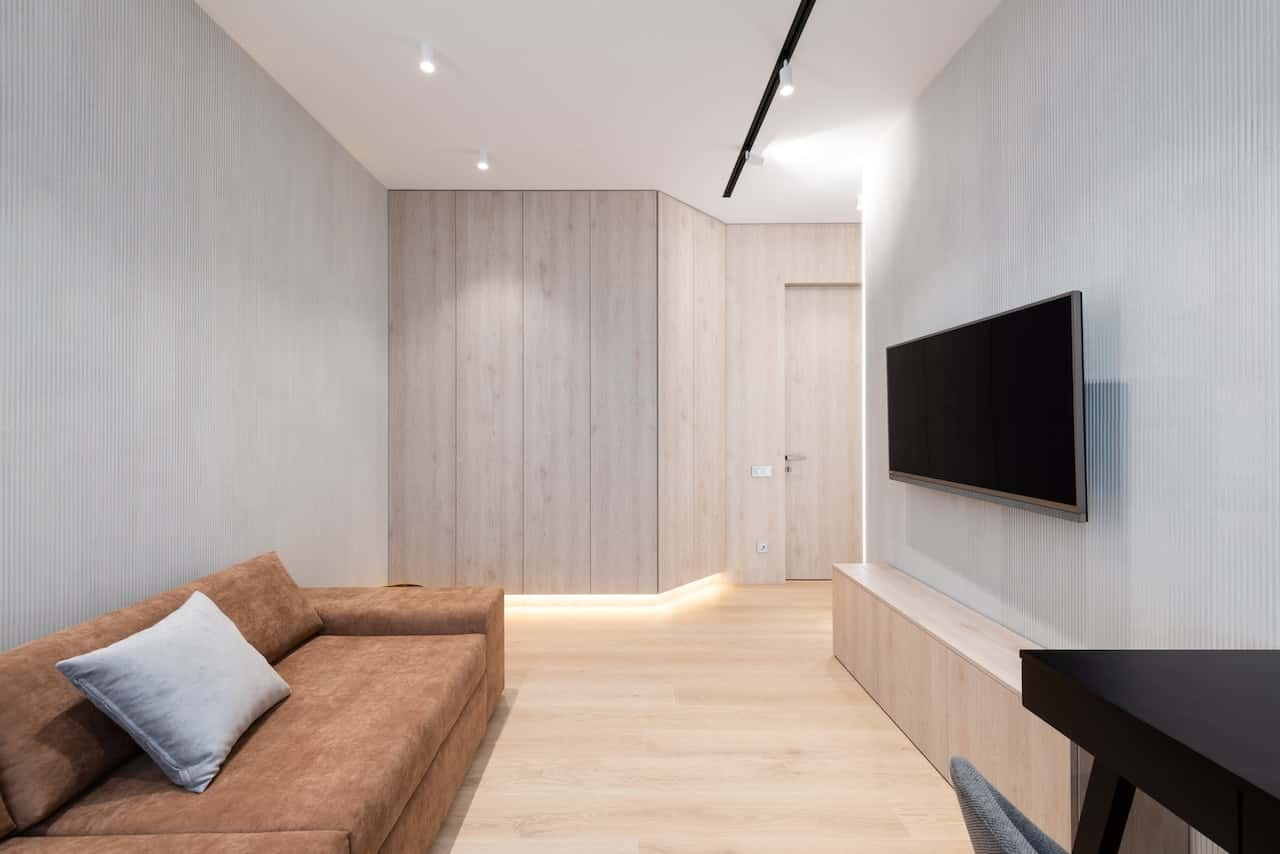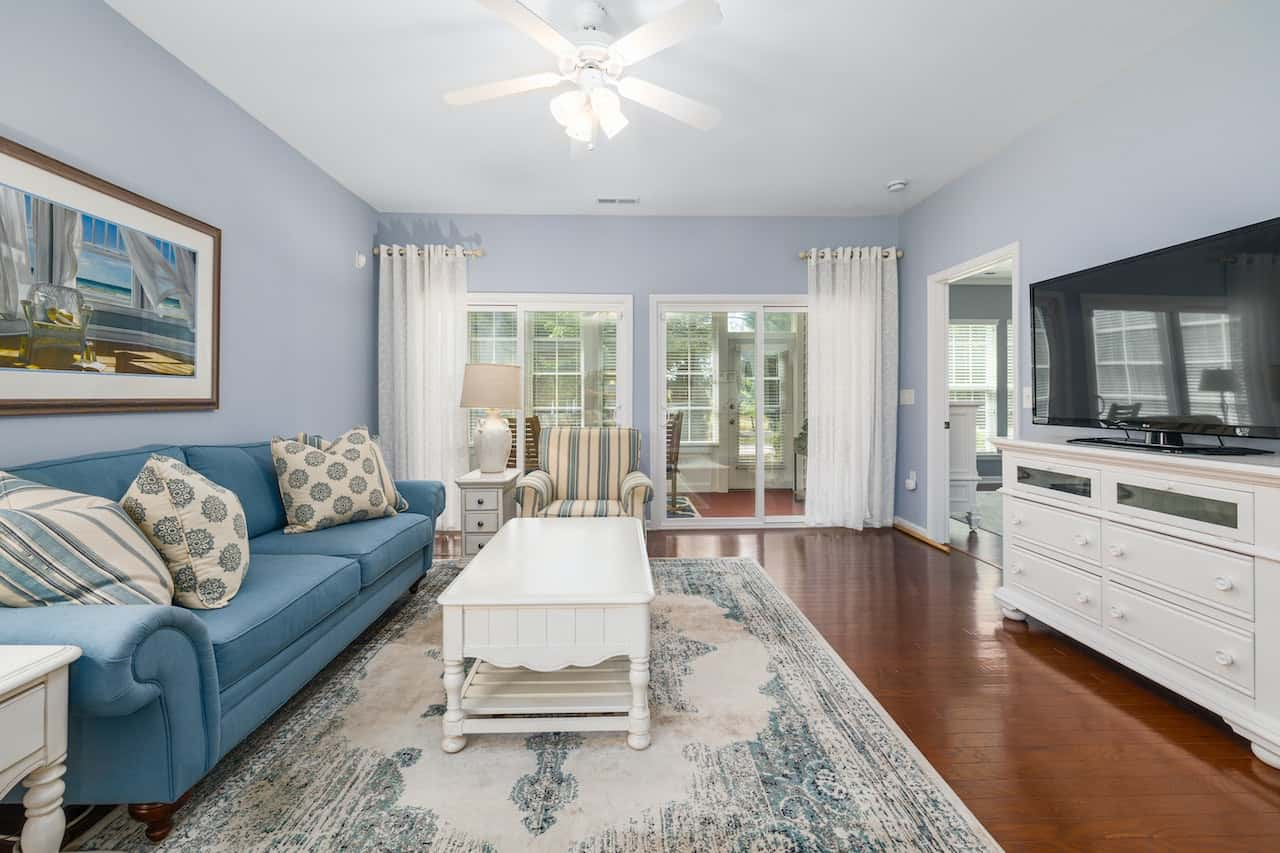There was a time when families would own one small box-sized TV set. Everyone would gather around it in the evenings to watch the few channels available. That’s long gone, of course.
TVs nowadays are large, flat and sleek. The most popular models have LED panels on which you can watch numerous channels, surf the Net and choose from streaming services. LED panels are composed of different layers to ensure accurate colour reproduction.
Such panels can conveniently fit into any room. They come in various sizes, sometimes up to 75 inches. They provide many opportunities in terms of interior décor.
For example, a TV or LED panel could be the focal point of a room. Alternatively, it could stay in a discreet corner. The display design could match the rest or the room, or it could serve as a counterpoint. It all depends on how often it is used and the décor of the rest of the house.

In Which Room Should You Place a TV?
For most people, the living room is the best place for a TV. After all, this is where everyone in the family gathers. It is also likely to be a place with comfortable sofas and other seating.
Nowadays, however, many households have more than one TV set. In that case, one is in the living room and the other in the bedroom.
A lot depends on viewing habits. The living room is the best place if there are popular programmes that are watched together. If watching is more individual, then it’s the bedroom.
The size of the LED panel matters, too. Typically, larger ones are in the living room, and more manageable sizes belong in the bedroom.
Families with large enough houses can plan what has been called a recreation room. This is a space used for activities such as indoor games, video games, casual get-togethers and other such social activities. Sometimes, basements or even attics can be converted into recreation rooms. A large LED panel is perfect for such areas.
Wherever you place it, the right LED panel design can make a big difference. That’s what we’re going to explore next.

LED Panel Design Choices
You can consider several options, from sleek and inobtrusive to larger and more organised. Before you decide, keep in mind the rest of your décor and how the LED TV panel design will look against it.
Below are some broad types of LED panel designs. When settling on one, you don’t have to rule out the others. The best part is you can mix and match among these. Various materials and styles can come together to create a unique look that’s just right for your interior.
Wooden
A wooden background makes a distinctive impression. It creates a classic frame for the LED panel and sets it apart from the surroundings. There are various types of wood to choose from: it could be dark or light, plain or with natural grain.

Contemporary
A contemporary LED panel design is chic and appealing. It uses few design elements but makes each one count. It can use acrylic or metal wall mounts. The best part of contemporary designs is that the LED panel becomes an interior element that is an integral part of contemporary décor.

Minimal
Like a contemporary design, a minimal style uses few elements. However, the emphasis here is not to make the TV stand out but incorporate it as a part of the background. A minimal style is preferred when you don’t want the LED panel to be seen as a separate part of your décor.

Cabinet
Many LED panel designs use cabinets. This is both practical and appealing. The cabinet is a convenient and handy place to keep other equipment associated with the TV, such as cables and accessories. It also doubles up as extra storage for smaller rooms.

Floating
In a floating design, the panel is mounted on a bare wall, giving it the impression of floating on its own. This gives it a sleek and modern vibe. An added advantage is that it saves space. The space below or on the sides can be used for electrical and storage.

Modular
A modular or built-in style is a modern LED panel design that makes use of separate components. These come together to create a unit within which the TV can fit perfectly. Each module can be used for a different purpose, such as storage, electrical, or other entertainment equipment.

Simple
For smaller spaces, a simple design is often best. This type of design does not have to look mundane. Simplicity means using only that which is strictly necessary for the LED panel. This could mean a shelf or a small table that matches the rest of the décor and on which the LED panel can stand.

Wall Design Tips for Specific Spaces
Here are some added tips to keep in mind according to the place in which you have decided to place the TV set.
LED panel design for small bedrooms: In this case, it would be best to keep the design simple and practical. For example, a wall mounts with a shelf below it. Or a modular pattern that also serves as a dressing table. Think of dual-use furniture to make the most of the space utilised by the LED panel.
LED panel design for drawing room: An LED panel design for a drawing room can be discreet or the focal point. It depends on how much it is used. With such designs, care should be taken so that the LED panel does not protrude and take up unnecessary space.
LED panel design for living room: Many interior designers make a difference between a living room and a drawing room. A drawing room is more formal, and a living room is more relaxed. As such, an LED panel design for a living room should be an unfussy and practical use of space.
LED panel design for the hall: As you must know, a hall is designated as the space just inside the front door when people walk into the house. With larger interiors, the hall leads to the other rooms of the house. The main hall LED panel design should not be obtrusive. Many prefer a wall-mounted effect.
LED panel design for the lobby: In a lobby area or any other entranceway, the same design principles should apply as in a hall. The design should be sleek, blend in, and not take up unnecessary space.

Some Other Considerations
While a proper design will take care of how the LED panel looks and fits in, you should not ignore practical issues. Often, these make a big difference to the comfort and usefulness of watching programmes and shows.
- The LED panel should be positioned at eye level. This means at the eye level of a person on a sofa in a living room or lying in bed in the bedroom, for example. If it is too low or too high, it can cause neck strain and discomfort due to an improper viewing angle.
- Naturally, a TV set or LED panel will need an electrical source as well as other connections. Your design should not ignore this. It should be close enough to a power source to begin with. Concealed wiring will impart a neat and clean look. You may need to consider a shelf or other space for leads, wires and other equipment that you connect to the panel from time to time.
- In a bedroom, the LED panel should be on the wall that is directly facing the bed. In other rooms, it can be placed at a central point or in a corner. What is important is that there is adequate seating in front of it, with the right viewing angles. Sometimes, a swivel stand is a useful addition.
- Lighting is another important factor. Ideally, the light source should be behind the TV set. It helps to place the panel in a location without glare and reflections from bulbs, windows and other bright sources.

Summing Up
There are as many choices for LED panel design as there are interiors themselves. To begin with, you can think of how often the TV is used and by whom. This will help you with the type of design, location, and seating. After that, you can choose a style that complements your interior without ignoring practical aspects.

At HomeLane, we know how important it is for you to get your interiors looking just right. LED panel design apart, we have tons of other marvellous suggestions to help you achieve this. To begin, take a look at some tips on designing a contemporary living room. After that, feel free to reach out for more.




